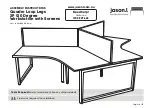
3 Introduction
3.1 Features
•
A two-piece optoelectronic safeguarding device
•
Creates a screen of synchronized, modulated infrared sensing beams that
extend from end-to-end of the sensors (no "dead zone")
•
Compact package for smaller production machines, robust for large power
presses
•
30 mm resolution
•
Defined areas of 300 mm (12 in) to 1800 (71 in) mm, in increments of 150
mm (6 in)
•
0.1 m to 12 m range (4 in to 39 ft); the range decreases with the use of
corner mirrors and/or lens shields:
◦
Lens Shields—an approximately 10% reduction in range per
shield
◦
Glass-surface mirrors—an approximately 8% reduction in range
per mirror
•
Zone and Status indicators for diagnostics
•
FMEA tested to ensure control reliability
•
Highly immune to EMI, RFI, ambient light, weld flash, and strobe light
•
Safety PLC input compatible (per OSSD specifications)
3.2 System Description
Banner S4B emitters and receivers provide a redundant, microprocessor-controlled, opposed-mode optoelectronic safety
light screen. S4B typically is used for point-of-operation safeguarding, and is suited to safeguard a variety of machinery.
The S4B emitters have a row of synchronized modulated infrared (invisible) light-emitting diodes (LEDs) in a compact
housing. Receivers have a corresponding row of synchronized photodetectors. The light screen created by the emitter and
receiver is called the defined area; its width and height are determined by the length of the sensor pair and the distance
between them. The defined area (sensing area) is equivalent to the height of the sensors. The maximum sensing range is 12
m (39 ft), which decreases if corner mirrors or lens shields are used. The sensing area extends from end to end of the
housing; there is no dead zone.
In typical operation, if any part of an operator’s body (or any opaque object) of more than a pre-determined cross section is
detected, the solid-state Output Signal Switching Device (OSSD) safety outputs turn OFF. These safety outputs are typically
connected to an external monitoring device such as a Banner XS26-2 Safety Controller.
Electrical connections (power, ground, inputs, and outputs) are made via M12 quick-disconnect connections.
All models require a supply voltage of +24 V DC ±15%.
Both the emitter and the receiver feature LEDs to provide continuous indication of operating status and error conditions.
All models include the ability to select between two scan codes.
S4B Safety Light Curtain
www.bannerengineering.com - Tel: + 1 888 373 6767
7








































